Topic Question Set
Q 1
:
A light ray enters through a right angled prism at point P with the angle of incidence 30° as shown in figure. It travels through the prism parallel to its base BC and emerges along the face AC. The refractive index of the prism is [2024]
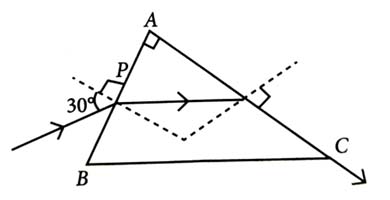

(2)
Let the refractive index of the prism be
Applying Snell’s law at point
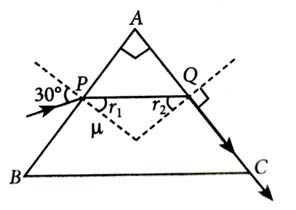
...(i)
Applying Snell’s law at point
(Using equation (i))
Q 2
:
A horizontal ray of light is incident on the right angled prism with prism angle 6°. If the refractive index of the material of the prism is 1.5, then the angle of emergence will be [2023]
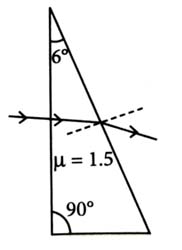

9°
10°
4°
6°
(1)
Q 3
:
Find the value of the angle of emergence from the prism. Refractive index of the glass is . [2021]
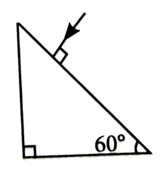

90°
60°
30°
45°
(2)
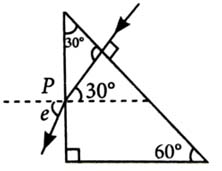
Let is angle of emergence and is angle of incidence.
From Snell’s law at point P
So,
Q 4
:
A ray is incident at an angle of incidence on one surface of a small angle prism (with angle of prism A) and emerges normally from the opposite surface. If the refractive index of the material of the prism is , then the angle of incidence is nearly equal to [2020]
(3)
Light ray emerges normally from another surface, so the angle of emergence (e) = 0.
Using Snell’s law on the first surface,
For small angles,
Hence,
Q 5
:
The refractive index of the material of a prism is and the angle of the prism is 30°. One of the two refracting surfaces of the prism is made a mirror inwards, by silver coating. A beam of monochromatic light entering the prism from the other face will retrace its path (after reflection from the silvered surface) if its angle of incidence on the prism is [2018, 2004, 1992]
60°
45°
30°
zero
(2)
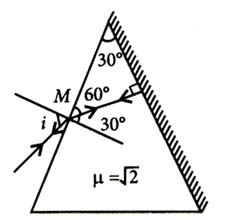
For retracing the path shown in the figure, the light ray should be incident normally on the silvered face. Applying Snell’s law at point M,
Q 6
:
The angle of incidence for a ray of light at a refracting surface of a prism is 45°. The angle of prism is 60°. If the ray suffers minimum deviation through the prism, the angle of minimum deviation and refractive index of the material of the prism respectively, are [2016]
45°;
30°;
45°;
30°;
(4)
Given,
Since the ray undergoes minimum deviation, therefore, angle of emergence from second face,
Q 7
:
A beam of light consisting of red, green and blue colours is incident on a right-angled prism. The refractive index of the material of the prism for the above red, green and blue wavelengths are 1.39, 1.44 and 1.47 respectively.
The prism will [2015]
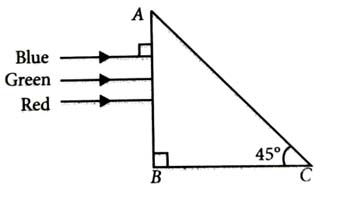

not separate the three colours at all
separate the red colour part from the green and blue colours
separate the blue colour part from the red and green colours
separate all the three colours from one another
(2)
As a beam of light is incident normally on the face AB of the right-angled prism ABC, no deviation occurs at face AB and it passes straight and strikes the face AC at an angle of incidence, .
For total reflection to take place at face AC,
where is the critical angle.
But as here and
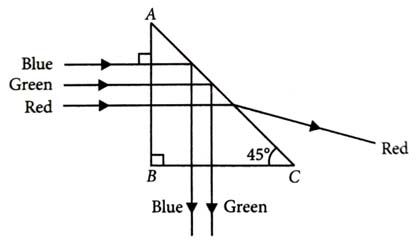
As while and , so only red colour will be transmitted through face AC while green and blue colours will suffer total internal reflection.
So the prism will separate red colour from the green and blue colours as shown in the given figure.
Q 8
:
The refracting angle of a prism is A, and refractive index of the material of the prism is cot (A/2). The angle of minimum deviation is [2015]
90° − A
180° + 2A
180° − 3A
180° − 2A
(4)
As
Q 9
:
The angle of a prism is A. One of its refracting surfaces is silvered. Light rays falling at an angle of incidence 2A on the first surface return back through the same path after suffering reflection at the silvered surface. The refractive index , of the prism is [2014]
2sinA
2cosA
cosA
tanA
(2)
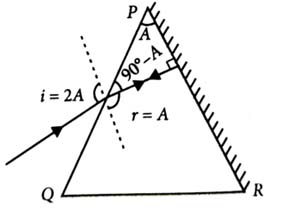
On reflection from the silvered surface, the incident ray will retrace its path, if it falls normally on the surface.
By geometry,
Applying Snell's law at surface

